How to Clean a Kitchen
In the bustling rhythm of our daily lives, the kitchen stands as more than just a functional space—it’s the heartbeat of our homes. Understanding the profound importance of a clean kitchen is not merely an acknowledgment of aesthetics but a commitment to the overall wellbeing of our households. A pristine kitchen transcends its utilitarian role, becoming a sanctuary where nourishment for both body and soul takes place. This guide on how to clean a kitchen is not just a compilation of cleaning tasks; it’s a testament to the profound connection between a hygienic culinary space and the holistic health of those who inhabit it. As we delve into the meticulous steps of this cleaning process, envision not just the eradication of grime but the cultivation of an environment where the joy of cooking and the pleasure of shared meals flourish seamlessly. This journey is not about chorelike obligations; it’s a celebration of creating a clean, organized haven where the act of preparing food becomes a source of joy and vitality. Let’s embark on this expedition, recognizing that a clean kitchen is more than a sterile space—it’s a cornerstone of a flourishing, nourishing home.
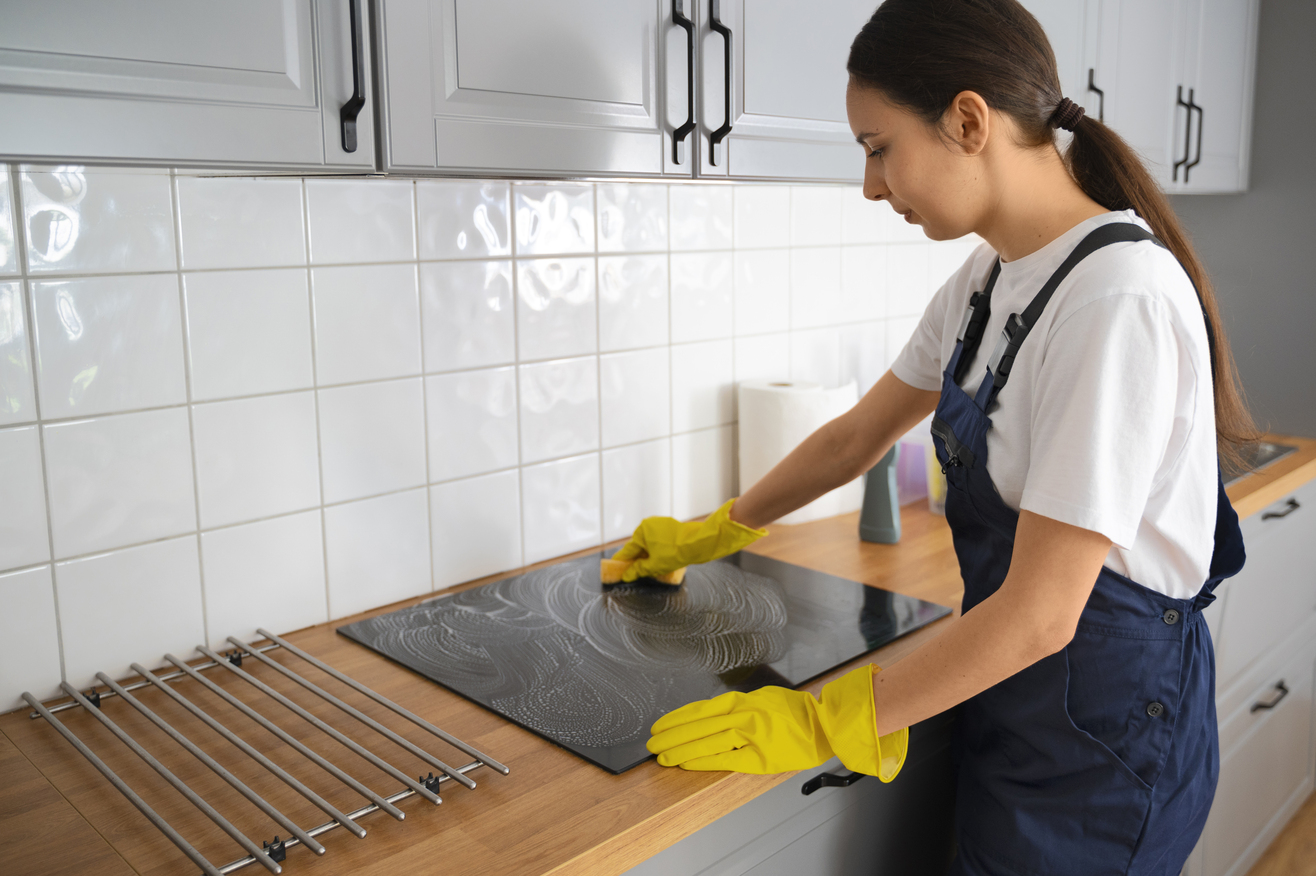
Prepare Yourself for a Flawless Kitchen Transformation
Before diving into the immersive experience of kitchen cleaning, a strategic and organized approach sets the stage for success. In this phase, we’re not just about tidying up; we’re orchestrating a symphony of cleanliness. Let’s explore the crucial steps in preparing your kitchen for a thorough cleaning adventure.
• Clearing Countertops and Surfaces:
Begin by liberating your countertops and surfaces from the burdens of everyday life. A clutterfree canvas allows for a more focused and efficient cleaning process. Sweep away the remnants of a hectic day, making space for the rejuvenation that follows.
• Organizing Utensils, Cookware, and Appliances:
In the dance of kitchen cleaning, every item has its place. Organize utensils, cookware, and appliances systematically. A well ordered kitchen not only streamlines the cleaning journey but also sets the foundation for a space where functionality and aesthetics coexist harmoniously.
• Essential Tools for Effective Cleaning:
Embarking on the journey to a sparkling kitchen involves more than determination—it requires the right tools to elevate the task from a chore to a gratifying experience. These essential cleaning tools are your allies in achieving a spotless kitchen, transforming the mundane into a celebration of cleanliness.
1 . Microfiber Cloths: Microfiber cloths’ fine fibers trap dust, dirt, and grime with exceptional efficiency, ensuring a thorough and streak free cleaning experience. Whether wiping down countertops, surfaces, or appliances, these clothes are gentle yet powerful, leaving your kitchen gleaming.
2 . Specialized Cleaning Solutions: Invest in specialized cleaners designed for various surfaces in your kitchen—countertops, appliances, and floors. From antibacterial solutions to grease cutting agents, having the right cleaner on hand ensures that each nook and cranny receives the treatment it deserves.
3 . Scrub Brushes: For those persistent stains and hard to reach corners, a trusty scrub brush is your goto companion. Choose brushes with sturdy bristles for surfaces that can withstand a more abrasive touch, and softer bristles for delicate areas.
4 . Sponges and Dishcloths: Sponges and dishcloths are the workhorses of kitchen cleaning. Use them for washing dishes, wiping surfaces, and even tackling spills. Opt for quality materials to ensure longevity, and keep a rotation to avoid the spread of bacteria.
5 . Vacuum Cleaner with Attachments: A vacuum cleaner with specialized attachments is the secret weapon for a comprehensive clean. From corners to crevices, let the vacuum effortlessly lift away hidden dirt, leaving your kitchen not just visibly clean but truly refreshed.
6 . Rubber Gloves: While protecting your hands, rubber gloves also enhance your grip and shield against harsh cleaning chemicals. Invest in a durable pair that provides comfort and flexibility, ensuring that your hands remain unscathed during the cleaning process.
Equip yourself with these essential tools, and witness the transformation of your kitchen cleaning routine into a joyful celebration of cleanliness. Each tool plays a unique role, contributing to the overall success of your cleaning expedition.
Clean the Appliances
Cleaning household appliances is an essential part of maintaining a hygienic and efficient kitchen. This section outlines specific techniques for cleaning various appliances to ensure they function optimally and remain in good condition.
1 . Microwave Cleaning Techniques
Microwaves are commonly used appliances that can accumulate food splatters and odors over time. Proper cleaning not only maintains hygiene but also prevents the transfer of unwanted flavors to your food.
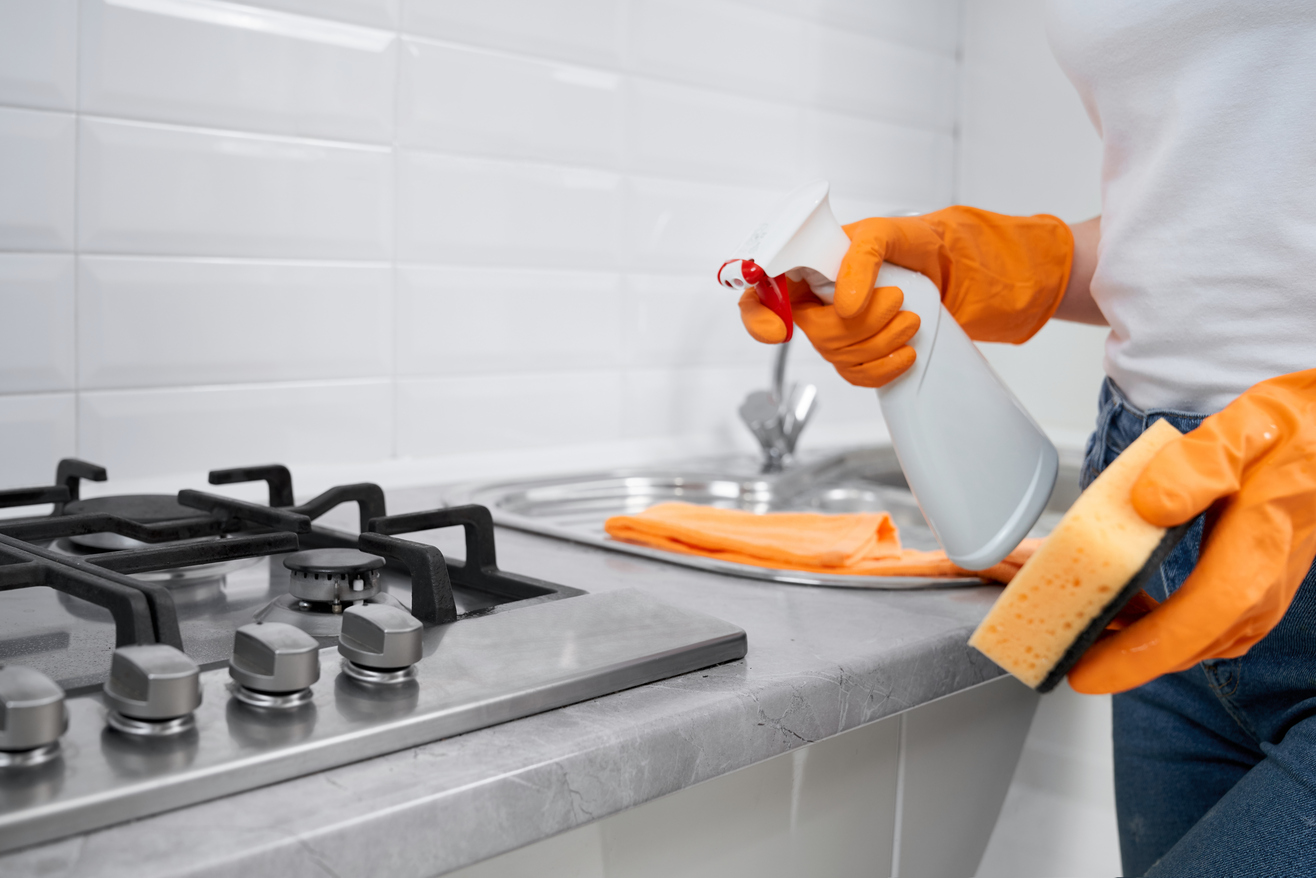
• Start by removing any removable components, such as the turntable and microwave safe containers.
• Wipe down the interior surfaces with a damp cloth or sponge.
• For stubborn stains, you can create a cleaning solution by mixing equal parts water and vinegar and heat it for a few minutes in the microwave. This will help loosen grime for easier cleaning.
• Wipe down the exterior surfaces of the microwave, including the control panel and door.
• For stainless steel microwaves, use a stainless steel cleaner to prevent streaks and maintain a polished appearance.
2. Oven and Stove Top Maintenance
Ovens and stovetops can accumulate grease and burnt residue, affecting both their appearance and functionality. Regular maintenance is crucial for preventing fire hazards and ensuring efficient cooking.
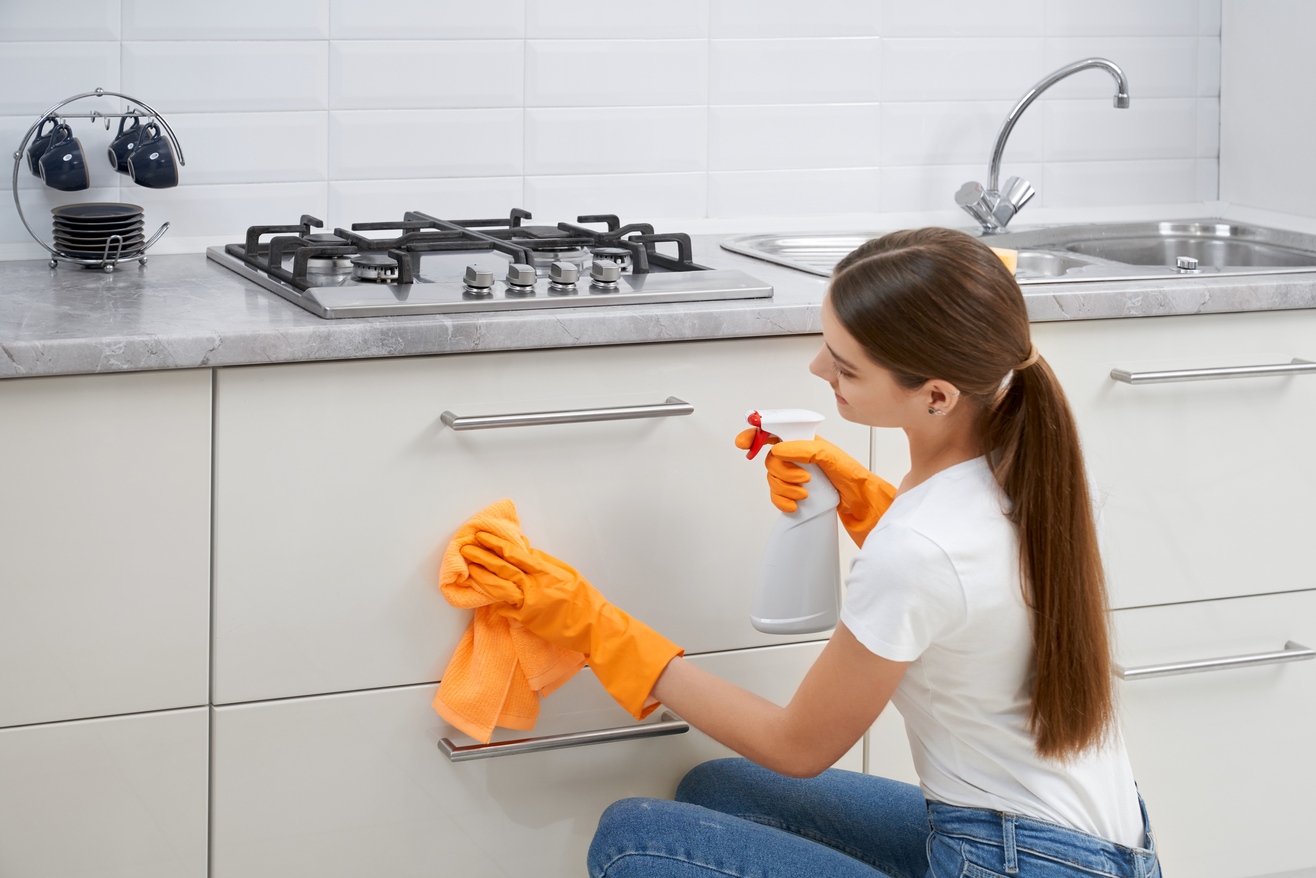
• Depending on the type of oven, you may use a commercial oven cleaner or a DIY solution of baking soda and water.
• Remove oven racks and trays for separate cleaning.
• Follow the product instructions or apply the baking soda paste, let it sit, and then scrub away the residue.
• Gas and electric stove tops require different cleaning methods.
• For gas stoves, remove grates and burner caps and soak them in soapy water.
• Wipe down the surface with a degreaser or a mixture of water and vinegar.
• Electric stove tops can be cleaned with a damp cloth and a mild cleaning solution. For stubborn stains, use a cooktop cleaner compatible with your stove.
3. Dishwasher Cleaning
Dishwashers play a crucial role in keeping your kitchenware clean. Proper care not only ensures effective cleaning but also extends the lifespan of the appliance.
• Regularly remove and clean the dishwasher’s filters. Rinse them under running water to remove food particles and debris. Follow the manufacturer’s guidelines for specific instructions.
• Wipe down the exterior of the dishwasher, including the control panel and door, using a damp cloth. For stainless steel exteriors, use a stainless steel cleaner to maintain a polished finish.
• By following these detailed cleaning techniques, you can keep your kitchen appliances in topnotch condition, promoting both hygiene and efficiency in your daily cooking activities.
• Regular maintenance not only enhances the performance of these appliances but also contributes to a clean and organized kitchen environment.
4. Tackling the Refrigerator
This section appears to be an overarching category for the cleaning process, indicating that the focus is on addressing various aspects of the refrigerator’s cleanliness.
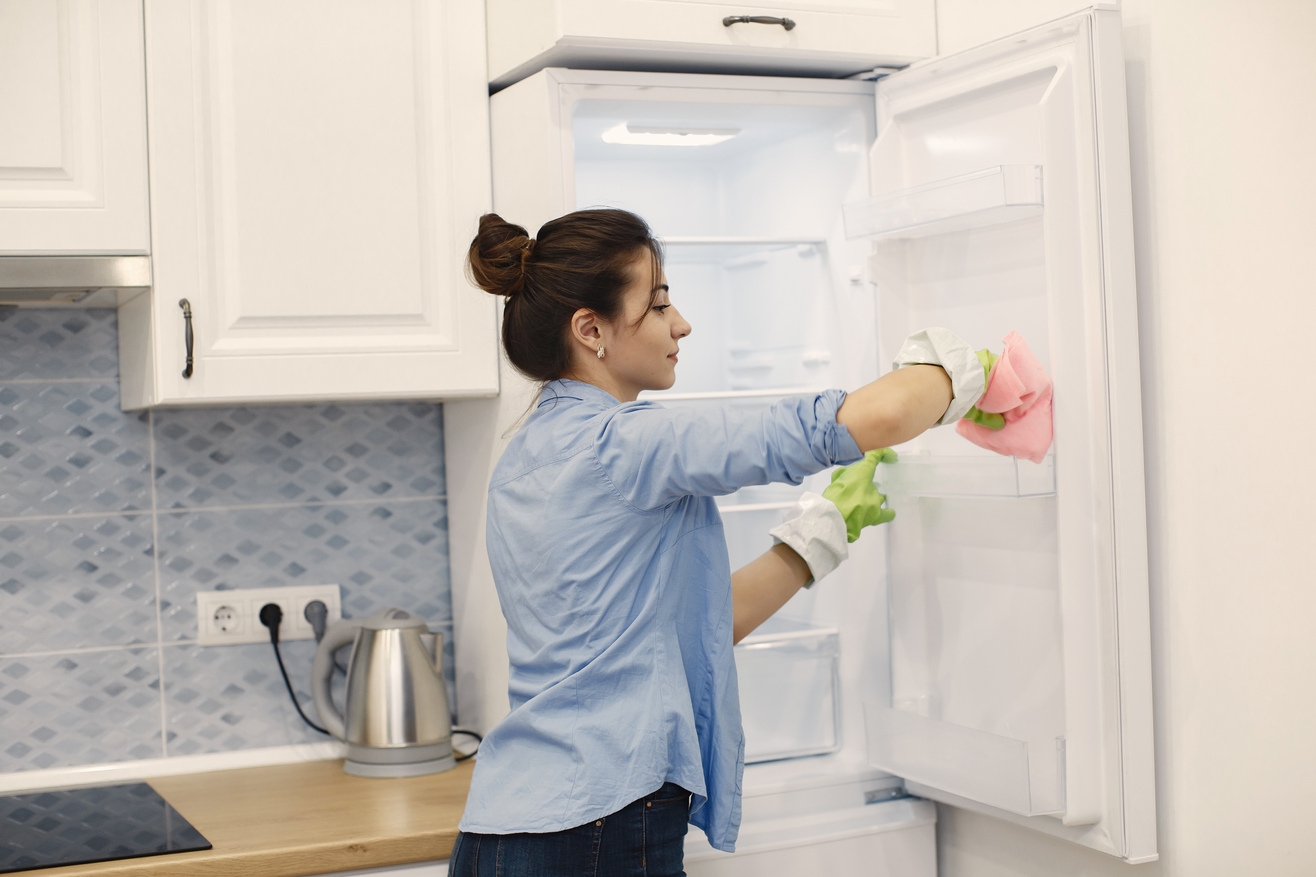
• The first step involves going through the contents of the refrigerator and identifying and removing any items that have passed their expiration dates.
• After discarding expired items, the next step is to clean the interior surfaces. This includes wiping down shelves and drawers to remove any spills, stains, or accumulated debris.
• Using a mild cleaning solution or a mixture of water and vinegar can be effective for this purpose.
• Here, the emphasis is on paying attention to the details of the refrigerator’s external surfaces. This may involve cleaning the top, sides, and front of the refrigerator, ensuring that no dust or dirt is accumulated in hard to reach areas.
• Proper cleaning of the door seal is important to maintain its effectiveness in keeping the cold air inside the refrigerator. A damp cloth or sponge can be used to wipe away any dirt, and mild soap can be applied for stubborn stains.
Following these steps can contribute to a clean and well maintained refrigerator, ensuring the freshness and safety of your stored food items.
Sanitizing Surfaces
Sanitizing surfaces is a crucial aspect of maintaining a clean and hygienic environment, particularly in spaces like kitchens where food preparation and various activities take place. In this section, we will delve into specific methods and considerations for sanitizing different surfaces within the kitchen.
• Countertop Cleaning
Ensuring the cleanliness of countertops is essential for food safety and overall hygiene in the kitchen. This involves not only removing visible dirt but also eliminating bacteria and germs that may be present. The following steps provide a comprehensive guide to effective countertop cleaning.
1 . Choosing Appropriate Cleaners: Selecting the right cleaning products is paramount to achieving optimal results. Different countertop materials require specific cleaners to prevent damage. For example, granite countertops may need gentler cleaners compared to laminate surfaces. Always refer to the manufacturer’s guidelines and choose disinfectants or sanitizers that are safe for the specific material.
2 . Microfiber Cloth Usage: Microfiber cloths are highly effective in capturing and removing bacteria from surfaces. They have the advantage of being reusable, reducing waste, and providing a streakfree finish. Proper technique, such as folding the cloth to expose a clean surface, ensures efficient cleaning without spreading contaminants.
• Cabinet and Cabinet Handle Sanitization
Maintaining the cleanliness of cabinets and cabinet handles is often overlooked but is essential for preventing the spread of germs in the kitchen.
Ensure to regularly wipe down cabinet surfaces using an appropriate cleaner that won’t harm the material. Pay extra attention to high touch areas like cabinet handles, as these are common points of contact. Using disinfectant wipes or a mixture of water and vinegar can effectively remove dirt and bacteria.
• Sink and Faucet Deep Clean
The kitchen sink and faucet can harbor a significant amount of bacteria, given their frequent use for food preparation and dishwashing. Deep cleaning of these areas is essential for preventing the cross contamination of surfaces and maintaining a healthy kitchen environment.
Consider using a disinfectant or a mixture of baking soda and vinegar to clean the sink. Pay attention to the faucet handles and the area around the sink drain. Scrubbing with an old toothbrush or a small brush can help reach crevices and corners.
Effective sanitizing of kitchen surfaces involves careful selection of cleaning products, proper use of cleaning tools, and attention to often overlooked areas. By following these guidelines for countertop cleaning, cabinet and cabinet handle sanitization, and sink and faucet deep cleaning, you can create a safe and hygienic kitchen environment.
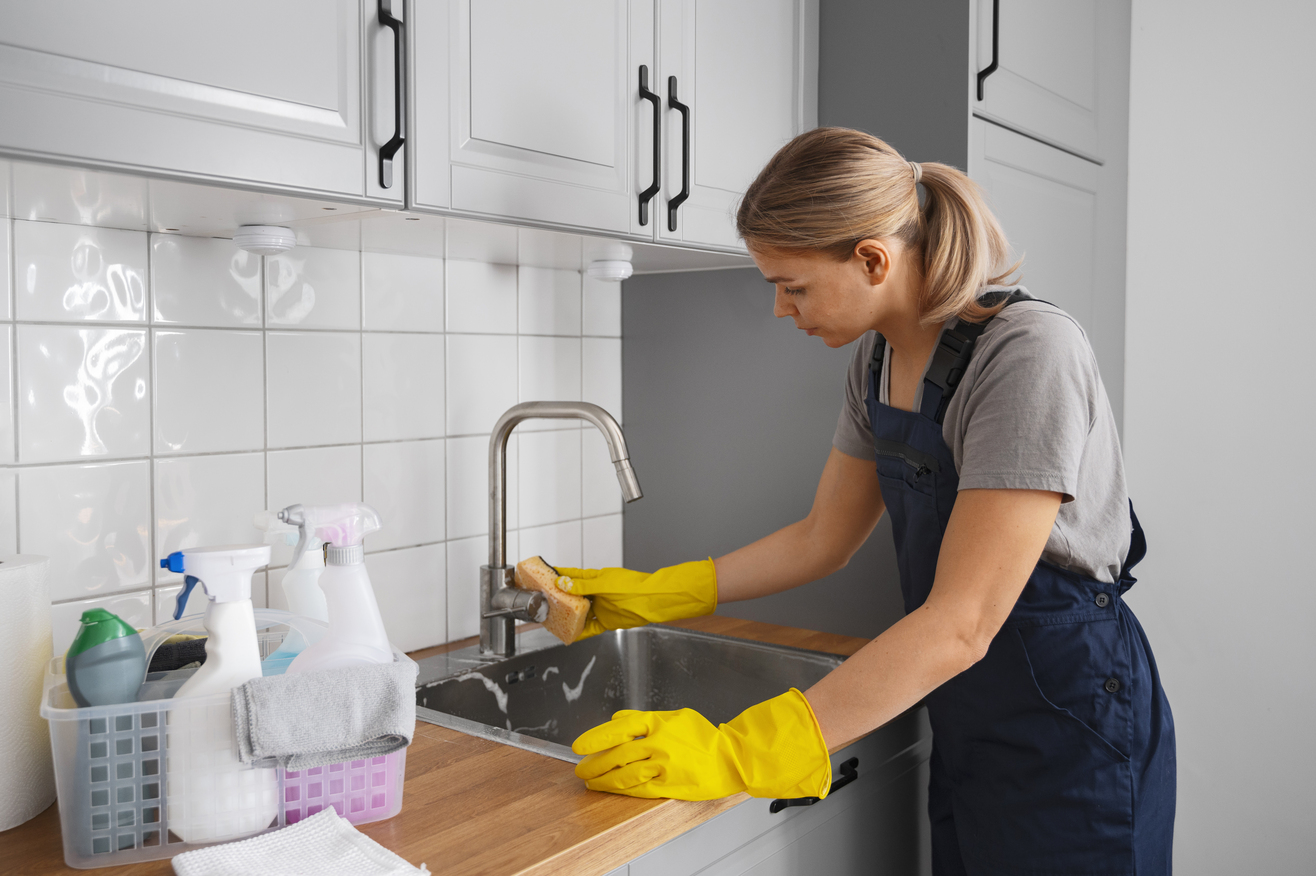
Floors Cleaning and Trash Management
Effective management of floors and trash is vital for maintaining a clean and hygienic environment within a space. This section outlines key practices for both floor cleaning and trash bin maintenance.

Efficient Floor Cleaning Process
Ensuring an efficient floor cleaning process involves a systematic approach to remove dirt, dust, and stains from various surfaces. Two fundamental steps are highlighted in this section.
• Sweeping: Initiate the process by using a broom or suitable cleaning tool to gather larger debris. Special attention should be given to corners and edges where dust tends to accumulate.
• Vacuuming: Employ a vacuum cleaner with appropriate attachments to effectively eliminate finer particles that may not be captured by sweeping alone.
• Mopping for a Fresh Look: Mopping adds the finishing touch to the floor cleaning process, ensuring a fresh and polished appearance. It is particularly effective in removing stains and spills, enhancing the overall cleanliness of the floor.
• Cleaning Process: Prepare a cleaning solution suitable for the floor type, ensuring compatibility with any applied finishes. Dip the mop into the cleaning solution, wring out excess liquid, and methodically mop the floor in systematic patterns. Pay special attention to high traffic areas and ensure thorough coverage.
• Frequency: While not as frequent as sweeping and vacuuming, mopping should be included in the regular cleaning routine to maintain a visually appealing and sanitary floor.
Trash Bin Maintenance
Trash bin maintenance is crucial for preventing odors, pests, and the spread of bacteria. This section outlines essential steps for proper trash bin care, including emptying, cleaning, and considerations for recycling and composting.

Regular emptying and cleaning of trash bins are essential practices to maintain a hygienic environment and prevent the accumulation of unpleasant odors.
Establish a consistent schedule for emptying trash bins, taking into account the volume and type of waste generated. Use appropriate protective gear, such as gloves, when handling waste. Wipe down the interior and exterior of the trash bins with a disinfectant to ensure thorough cleanliness. Trash bins should be emptied daily or as needed, and a more comprehensive cleaning can be performed on a weekly basis.
By adhering to the outlined procedures for efficient floor cleaning and trash bin maintenance, one can establish a comprehensive and effective cleaning regimen for a clean, organized, and aesthetically pleasing space.
Maintaining a Pristine Kitchen: Tips and Tricks for Effortless Cleanliness
A well maintained kitchen is the heart of a home, where meals are prepared, memories are made, and families gather. Keeping this essential space organized and clean not only enhances its functionality but also contributes to a healthier and more enjoyable cooking experience. In this article, we’ll explore a variety of tips and tricks for maintaining a pristine kitchen effortlessly.
1. Efficient Daily Cleaning Routine
Establishing a consistent daily cleaning routine is the cornerstone of a well maintained kitchen. This routine should include wiping down countertops, cleaning spills promptly, and doing a quick sweep or vacuum to eliminate crumbs and debris. By addressing messes as they occur, you prevent the accumulation of dirt and make the overall cleaning process more manageable.
2. Regular Appliance Maintenance
Kitchen appliances, such as ovens, microwaves, and refrigerators, play a pivotal role in daily food preparation. Regular maintenance ensures their optimal functionality and extends their lifespan. Schedule periodic deep cleans, remove expired items from the refrigerator, and follow manufacturers’ recommendations for maintaining appliances.
3. Organized Storage Spaces
Maintaining an organized kitchen starts with well arranged storage spaces. Invest in storage solutions such as labeled containers, pullout shelves, and drawer dividers to keep utensils, pots, and pans in order. Regularly declutter cabinets and discard items you no longer need to create a more efficient and visually pleasing kitchen environment.
4. Replenishing Cleaning Supplies
Fresh cleaning supplies are essential for effective kitchen maintenance. Regularly replace sponges, dish towels, and cleaning cloths to prevent the spread of germs. Consider using environmentally friendly cleaning products to create a healthier kitchen environment for your family.
5. Mindful Trash Management
An often overlooked aspect of kitchen maintenance is proper trash management. Empty trash bins regularly, and consider separating recyclables and compostables. This not only maintains cleanliness but also contributes to a more sustainable and environmentally friendly kitchen.
6. Investing in Quality Cookware
Quality cookware not only enhances your culinary skills but also simplifies the cleaning process. Invest in nonstick pans, stainless steel utensils, and dishwasher safe items to make postcooking cleanup a breeze. Follow care instructions to ensure the longevity of your cookware.
7. Preventing and Addressing Stains
Stains on countertops, floors, and appliances can be unsightly and challenging to remove if left unattended. Promptly address spills and stains with appropriate cleaning solutions. Regularly apply sealants to surfaces to prevent stains and make cleaning easier.
8. Seasonal Deep Cleaning
In addition to daily and weekly routines, schedule seasonal deep cleaning sessions. This involves cleaning areas that may be overlooked in regular routines, such as behind appliances, inside cabinets, and underneath the sink. A thorough seasonal clean ensures that every nook and cranny is addressed.
9. Creating a Maintenance Calendar
To stay organized and ensure no task is overlooked, create a maintenance calendar. Outline daily, weekly, monthly, and seasonal tasks. This visual guide helps you stay on track and ensures that your kitchen is consistently well maintained.
Maintaining a pristine kitchen is a combination of daily habits, regular deep cleaning, and investing in quality tools and cookware. By incorporating these tips and tricks into your routine, you’ll not only enjoy a cleaner and more organized kitchen but also make the heart of your home a space where both culinary creativity and family connections flourish.at may be overlooked in regular routines, such as behind appliances, inside cabinets, and underneath the sink. A thorough seasonal clean ensures that every nook and cranny is addressed.
Revitalize Your Space with Canes Cleaners: Premier Home and Apartment Cleaning in Miami
“Canes Cleaners,” based in the vibrant city of Miami, USA, is your go-to solution for top-notch home and apartment cleaning services. Specializing in meticulous and comprehensive cleaning, their team of professionals is committed to transforming your living spaces into pristine havens. When it comes to maintaining a hygienic and welcoming home, the kitchen plays a pivotal role. Here’s where the expertise of Canes Cleaners truly shines. Recognizing the importance of a sanitized and organized kitchen, their skilled professionals go beyond surface-level cleaning. They understand the nuances of kitchen maintenance, tackling grease, grime, and hard-to-reach areas with precision. By availing the services of Canes Cleaners, you not only ensure a spotless living environment but also safeguard the health and well-being of your loved ones. Don’t let the demands of a busy life compromise the cleanliness of your home—trust Canes Cleaners to deliver exceptional results. Elevate your living experience in Miami with the expertise of professionals who understand the significance of a sparkling clean kitchen and home. Schedule your appointment today and experience the transformative difference that Canes Cleaners brings to your living spaces.
Wrapping it Up: How to Clean the Kitchen
In conclusion, mastering “how to clean a kitchen” involves a systematic approach that encompasses various key cleaning steps. The importance of maintaining a clean and organized kitchen cannot be overstated. Recapping the key cleaning steps, from daily routines to seasonal deep cleaning, underscores the comprehensive nature of a well-maintained kitchen. As we’ve explored, a clean kitchen is not just about aesthetics; it directly impacts our daily lives. Affirming the benefits of a clean kitchen, such as improved hygiene, enhanced efficiency, and a more enjoyable cooking experience, reinforces the significance of investing time and effort into its upkeep. Finally, emphasizing the importance of regular maintenance serves as a reminder that a healthy living environment is an ongoing commitment. By integrating these cleaning practices into our routines, we not only create a welcoming and functional space but also contribute to the overall well-being of ourselves and our families. In essence, understanding “how to clean a kitchen” is not just about the process; it’s a commitment to fostering a healthier and happier home.
